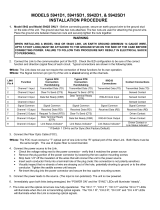
Testing the block input, interaction between FDPSPDIS (21)
or FRPSPDIS (21) and ZMRPSB (78)........................................102
Completing the test.....................................................................102
Out-of-step protection OOSPPAM...................................................102
Verifying the settings.................................................................. 103
Test of point RE (R
FwdR
, X
FwdX
)................................................. 108
Test of the boundary between zone 1 and zone 2, which is
defined by the parameter
ReachZ1
............................................ 113
Test of the point SE (R
RvsR
, X
RvsX
).............................................117
Current protection................................................................................. 122
Four step phase overcurrent protection 3-phase output
OC4PTOC (51_67).......................................................................... 122
Verifying the settings.................................................................. 122
Completing the test.....................................................................124
Four step residual overcurrent protection, (Zero sequence or
negative sequence directionality) EF4PTOC (51N/67N)................. 124
Four step directional ground fault protection.............................. 124
Four step non-directional ground fault protection....................... 125
Completing the test.....................................................................125
Four step negative sequence overcurrent protection NS4PTOC
(46I2)............................................................................................... 125
Completing the test.....................................................................126
Sensitive directional residual overcurrent and power protection
SDEPSDE (67N)..............................................................................126
Measuring the trip and time limit for set values.......................... 127
Completing the test.....................................................................133
Thermal overload protection, one time constant, Fahrenheit/
Celsius LFPTTR/LCPTTR (26)........................................................133
Measuring the trip and time limit of set values........................... 133
Completing the test.....................................................................134
Directional underpower protection GUPPDUP (37).........................134
Verifying the settings.................................................................. 134
Completing the test.....................................................................136
Directional overpower protection GOPPDOP (32).......................... 136
Verifying the settings.................................................................. 136
Completing the test.....................................................................137
Voltage protection.................................................................................137
Two step undervoltage protection UV2PTUV (27).......................... 137
Verifying the settings.................................................................. 137
Completing the test.....................................................................138
Two step overvoltage protection OV2PTOV (59)............................ 139
Table of contents
4
Commissioning manual






















